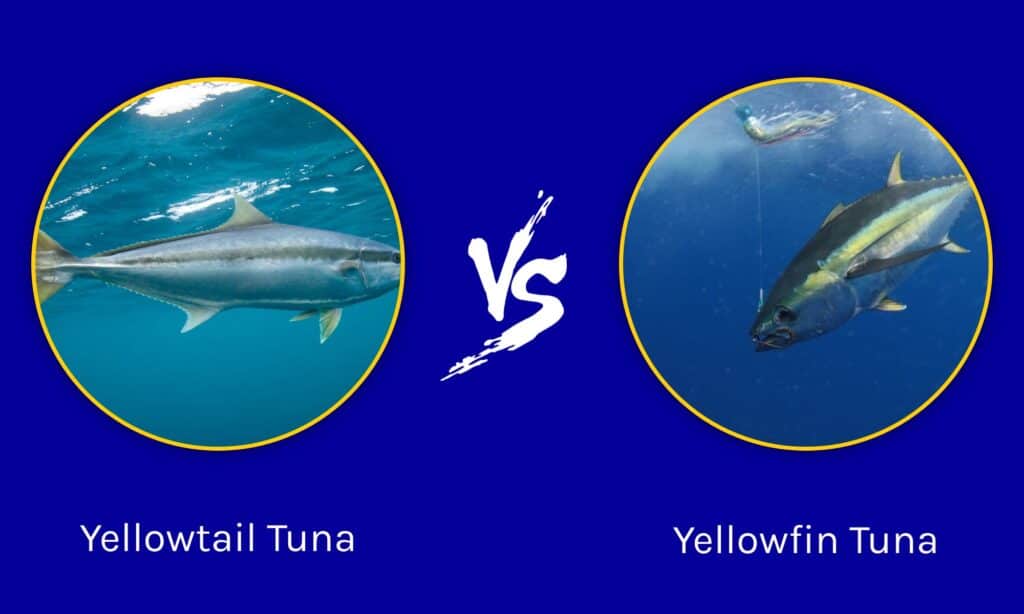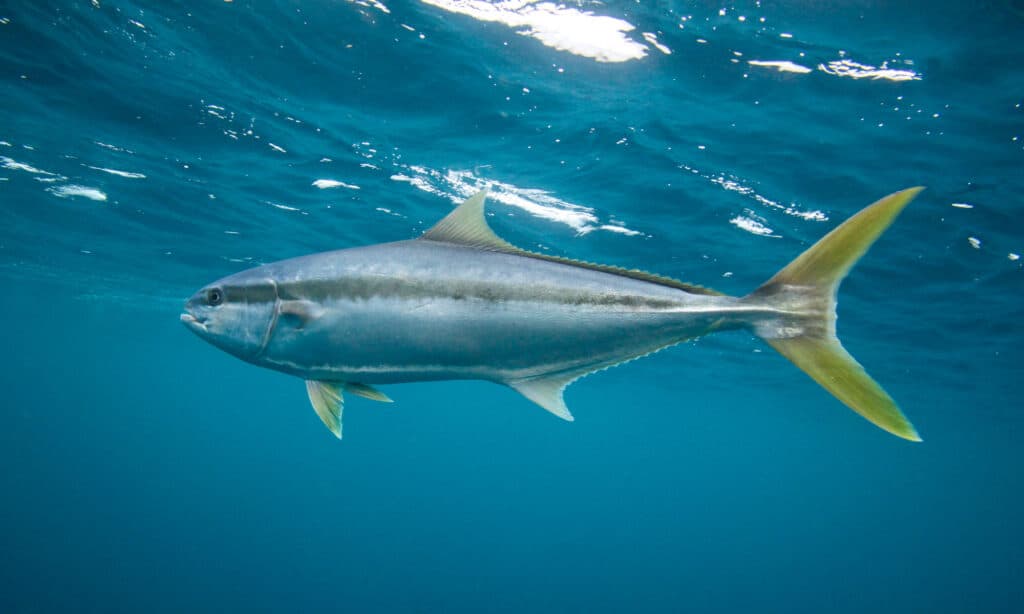Yellowtail and yellowfin tuna are completely different fish species with striking similarities. Yellowtails are Atlantic and Pacific fish in the genus Seriola of the family Carangidae, usually considered “amberjacks,” while yellowfins are tuna species found in pelagic waters across the globe.
Both fish have similar bright yellow colors on their dorsal, anal, and tail fins, which is probably where the confusion occurs. Let’s examine the key differences between the yellowtail and yellowfin tuna to help you discern between the two.
Comparing Yellowtail vs Yellowfin Tuna

| Key Differences | Yellowtail | Yellowfin Tuna |
|---|---|---|
| Classification | Kingdom- Animalia Phylum- Chordata Class- Actinopterygii Order- Carangiformes Family- Carangidae Genus- Seriola Species- Seriola lalandi | Kingdom- Animalia Phylum- Chordata Class- Actinopterygii Order- Scombriformes Family- Scombridae Genus- Thunnus Species- Thunnus albacares |
| Size | Weight- up to 80 pounds (36 kg) Length- up to 30 inches (2.5 feet) | Weight- up to 450 pounds (204 kg) Length- up to 2 m (7 feet) |
| Color | Blue, silvery-white, yellow | Yellow, blue, silver |
| Diet | Squid, crab, garfish, sardines, erring, anchovies | Fish, crustaceans, mollusks |
| Habitat and distribution | -Spend a lot of time near the coast and rocky reefs and occasionally enter estuaries -Often found in the Southern Hemisphere waters and sometimes in Northern Hemisphere waters during particular times of the year | -Live within the mixed surface layer of the ocean, though they are capable of diving to considerable depths -They are found throughout the Pacific, Atlantic, and Indian Oceans |
| Reproduction | Females release up to 150 eggs when spawning | Females release millions of eggs when spawning |
| Life span | 5-6 years | 7-8 years |
| Conservation status | Least Concern | Near Threatened |
8 Key Differences Between Yellowtail and Yellowfin Tuna
Although the yellowtail and yellowfin tuna have a lot in common, size is a key difference between the two species. Yellowfin tunas are larger than yellowtails and are often referred to as “Cows” by the long-range communities targeting tuna species in oceans worldwide from late spring to fall.
Other key differences between the yellowtail and yellowfin tuna include their appearance, habitat and distribution, lifespan, and conservation status. Let’s discuss all these differences in more detail to help you understand better.
Yellowtail vs Yellowfin Tuna: Classification

The yellowfin tuna is scientifically named
Thunnus albacares.
©Al McGlashan/Shutterstock.com
The scientific name of the yellowtail is Seriola lalandi. Seriola is a diminutive feminine form of seria, a more extensive earthenware pot. The second word “lalandi” comes from a naturalist named Monsieur de Lalande, who was the first person to tell zoologist Achille Valenciennes about yellowtail species.
On the contrary, the yellowfin tuna is scientifically named Thunnus albacares, a combination of two Latin words: albus, which means white, and caro, meaning flesh. Yellowfin tuna is commonly known as Ahi, a Hawaiian name that is also used for the closely related bigeye tuna.
Yellowtail vs Yellowfin Tuna: Size

The yellowtail is a medium-sized fish with a long, fusiform body that can grow to about 30 inches in length.
©Alessandro De Maddalena/Shutterstock.com
The yellowtail is a medium-sized fish with a long, fusiform body that can grow to about 30 inches (2.5 feet) in length and weigh approximately 80 pounds (36 kg) or more. Unlike the yellowtail, the yellowfin tuna is a bit larger.
The yellowfin tuna is among the most extensive tuna species, weighing up to 450 pounds (204 kg) with a total length of up to 2 m (7 feet). However, the yellowfin tuna is significantly smaller than the Atlantic and Pacific bluefin tuna, reaching over 990 pounds (450 kg).
Yellowtail vs Yellowfin Tuna: Color

The upper dorsal side of the yellowtail is blue, with a silvery-white color on its lower flanks and belly.
©Alessandro De Maddalena/Shutterstock.com
The upper dorsal side of the yellowtail is blue, with a silvery-white color on its lower flanks and belly. It also has a distinct bronze-colored stripe that runs along the middle of its body and transitions near the tail to a yellow color. Like the yellowtail, yellowfin tuna also has yellow fins. However, the yellowfin tuna is characterized by a dark blue back and yellow side, which fade to silver around the belly.
Yellowtail vs Yellowfin Tuna: Diet
Yellowtail and yellowfin tuna are very active predators. However, their diet preferences slightly differ between the two species. Yellowtails prefer a diet that consists of squids, garfish, sardines, herrings, and anchovies. On the other hand, yellowfin tunas mainly prey on crustaceans, squids, and mollusks.
Yellowtail vs Yellowfin Tuna: Habitat and Distribution

Yellowfins inhabit the mixed surface layer of the ocean and are also capable of diving to considerable depths.
©Al McGlashan/Shutterstock.com
Yellowtails spend most of their time near rocky reefs and adjacent sandy areas beside the coast. They occasionally enter the estuaries and occupy shallow water down to depths of up to 50 m. However, some yellowtail species have been caught in depths of about 300 m.
Yellowtails were initially thought to be found in all seas and oceans across the globe. However, recent genetic analysis restricts most Seriola species to the Southern Hemisphere waters, and a few are found in Northern Hemisphere waters at certain times of the year.
Yellowfin tunas inhabit the mixed surface layer of the ocean. They are also capable of diving to considerable depths. Most yellowfin tunas range in the water column’s top 330 feet (100 m). They are found throughout the Pacific, Atlantic, and Indian Oceans.
Yellowtail vs Yellowfin Tuna: Reproduction
Both yellowtails and yellowfin tunas release their gametes into the water column, where external fertilization occurs. During the spawning season, which usually occurs throughout the summer, female yellowtails may release up to 150 eggs at a time. About 100 of these eggs are likely to be fertilized.
Unlike yellowtails, female yellowfin tunas produce an average of one to four million eggs every time they spawn. Besides, they breed all year round, with the peak spawning season occurring in the summer. However, only a very small fraction of young yellowfin tunas will be able to survive to adulthood.
Yellowtail vs Yellowfin Tuna: Lifespan
Young yellowtails and yellowfin tunas become sexually mature at about 2-3 years of age. Most yellowtails live for five to six years. However, yellowtail species in captivity may live a maximum lifespan of approximately twelve years. On the contrary, yellowfin tunas may live for about seven or eight years.
Yellowtail vs Yellowfin Tuna: Conservation Status
With relatively healthy populations and widespread distribution, the yellowtail is listed on the IUCN Red List of Threatened Species as of least concern. In contrast, the yellowfin tuna is listed as near threatened.
The photo featured at the top of this post is © Alessandro De Maddalena/Shutterstock.com
Thank you for reading! Have some feedback for us? Contact the AZ Animals editorial team.






